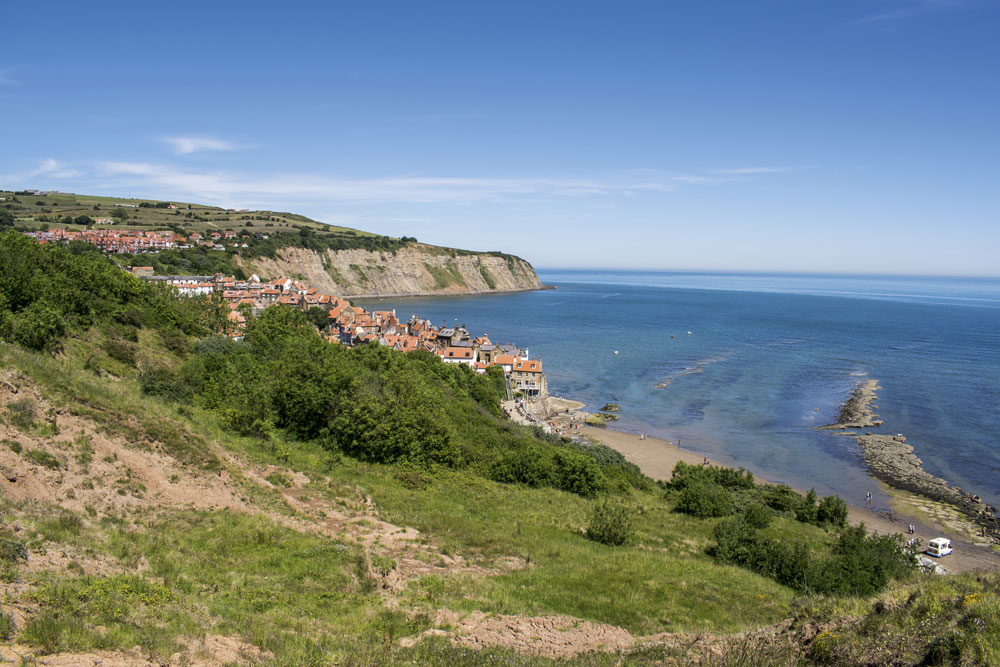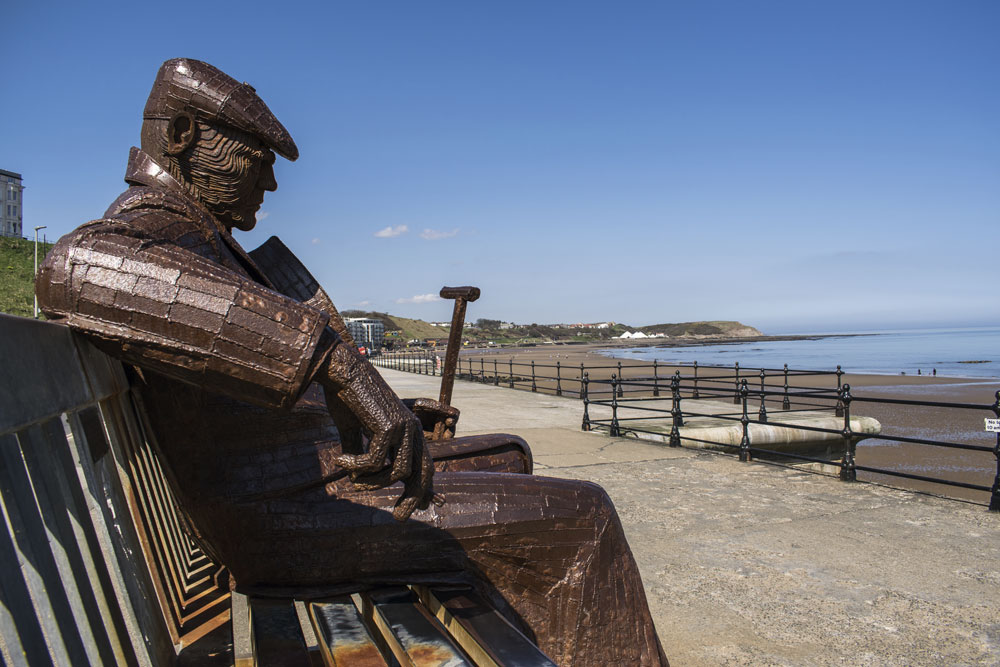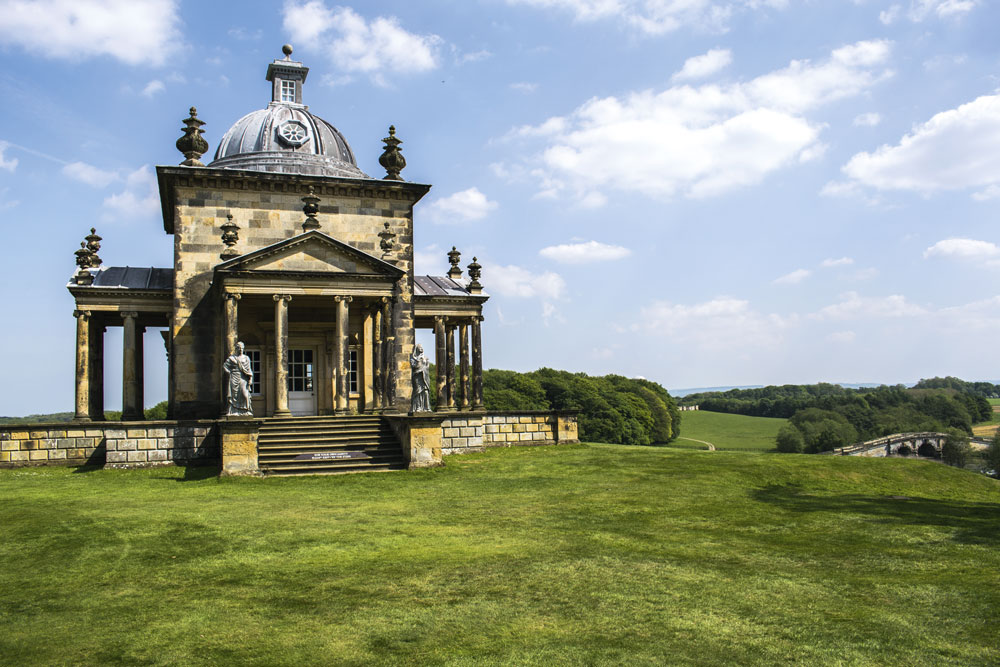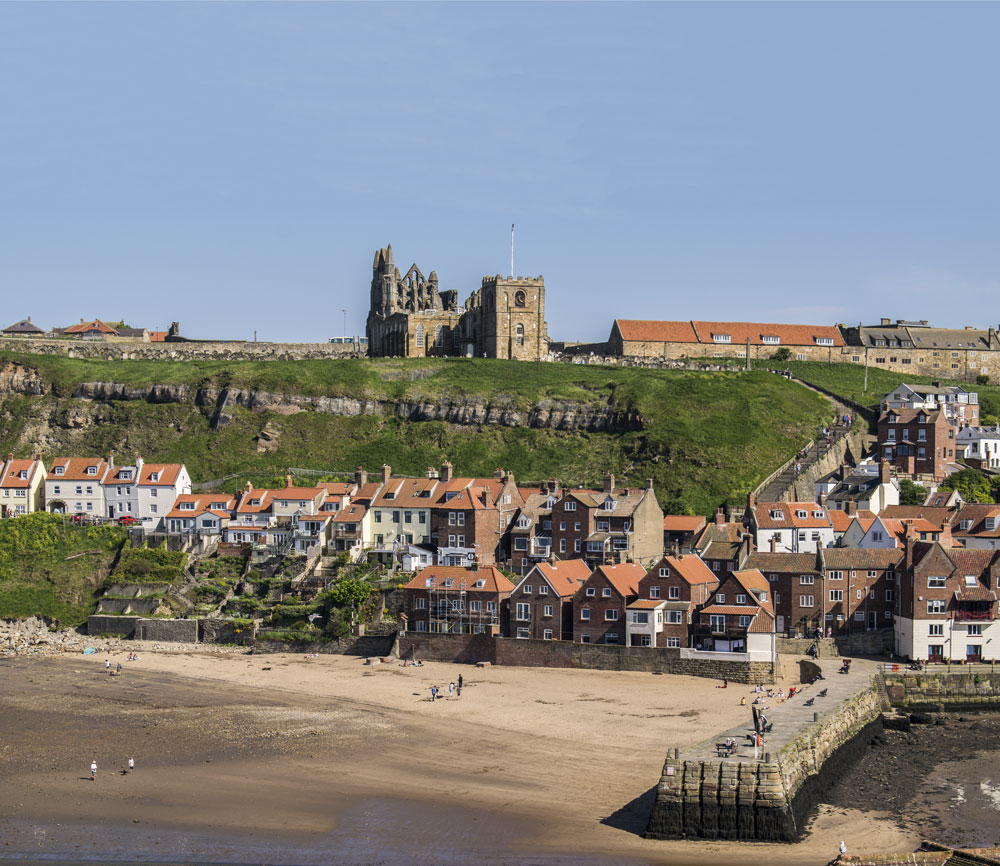Motorhome travel: The many faces of north Yorkshire
Words and photos: Carol Burkinshaw
Chart clasped in one hand, Captain James Cook proudly stands on Whitby’s West Cliff. Yet he must have been bemused that he had weathered everything the high seas could have thrown at him on his epic voyages of discovery, but that a boisterous North Sea had postponed the welcome party – which we had joined – to greet the full-size replica of his ship Endeavour being towed into Whitby harbour from Middlesbrough.
It was somewhat frustrating, yet we enjoyed watching the ebb and flow of life from the commanding position of the Cook Monument over Whitby’s vast natural harbour at the mouth of the Esk and the long, pincer-shaped piers pulling boats into its safe haven or releasing them out to sea.
Just yards away, Whitby’s whalebone arch, framing a classic image of the ruined abbey on the East Cliff, was looking worn. The wider panorama of the old town against the backdrop of the Gothic abbatial remains didn’t disappoint.
Cook had crafted his seamanship skills in Whitby and all four of the ships that he sailed on his three circumnavigations were built in the town. The Endeavour replica is now a floating museum depicting eighteenth century life at sea.
To get into the Whitby spirit, I’d recently sunk my teeth into Bram Stoker’s Dracula horror novel. We, however, unlike the vampire shapeshifting dog, didn’t leap up the town’s famous 199 steps to the Caedmon Cross on our way to the abbey as every few strides enticingly unfolded better views.
Along the coastal path beyond the abbey the crowds soon evaporated, but we were being teased by a flirty mist. Atmospheric as it was to watch motorhomes at Whitby Holiday Park swirling in and out of the sea fog on a grassy plateau high above Saltwick Bay, we were happy to be pitched at the sheltered Ingledene Beckside Campsite on the fringe of Pickering.
At Robin Hood’s Bay, the coast was clear again. We smuggled ourselves into a tightly packed ravine of fishermen’s cottages, passageways and underground tunnels that tumble steeply down to the sea; a perfect cloak for a past community-based enterprise that spirited away contraband from the prying eyes of the excise men.

Looping back to Whitby along the Cinder Track – the disused Scarborough-Whitby railway line – we were intrigued by the railway carriages at the former Hawsker station. These provide quirky self-catering accommodation alongside a café. With flagging energy levels, the viaduct over the Esk approaching Whitby was a welcome sight. It was a relief that, for once, we didn’t have to queue harbourside as crates of fish were carried into the Magpie Café. The Magpie’s fish ‘n’ chips are unbeatable!
Thoughts of revisiting Scarborough jumpstarted some fond childhood recollections. When I was a youngster, my grandparents had a static caravan just south of the town at Cayton Bay.
From Scalby Mills, at the northern end of Scarborough, we took the higher ground past the open-air theatre. Here, back in the 70s, the hilarious antics of It’s a Knockout! were a favourite of mine, as were the mock naval battles deploying model boats on the lake in the neighbouring Peasholm Park.
From the ruins of the castle, clamped limpet-like to the summit of a precipitous headland, the outlook along Scarborough’s curving North and South Bays was bracingly good. Down at harbour level, looking back up to the clifftop Norman stronghold I realised I’d never really noticed the fortification as a child. Sandcastles, along with donkeys, ice cream, candy floss and dodgem cars, were all that mattered then.
Secreted from view, unless approaching from the sea, the statue of the Diving Belle is behind the lighthouse on Vincent Pier. Circling around her she looked so elegant from every perspective. Standing tall, with long arms outstretched, her lean, toned body is poised ready to plunge into the sea.
The promenade led us around the base of the castle promontory to the North Bay where we met ‘Freddie Gilroy and the Belsen Stragglers’. Freddie, a former miner, was a pal of his sculptor. He was also one of the first soldiers to be relieved from the Bergen-Belsen concentration camp and poignantly represents ordinary people forced into extraordinarily difficult lives during the World Wars.

Larger than life, he sits on a bench in his overcoat, with one arm casually draped over the back of the bench and his other hand loosely holding a walking stick. His cloth cap is pulled slightly down as he watches the world go by. He also patiently accepts the attention of all ages wanting their photograph taken with him.
Waking early to a clear and windless morning we drove up to the rim of the Hole of Horcum at Saltergate. We had the best seat in the house – and all to ourselves – across this vast natural amphitheatre scooped out into the North York Moors. As we enjoyed our breakfast there was such a sense of space and tranquillity. The light was so sharp everything appeared in high definition.
Even without a blaze of summery purple heather, following the classic loop through the fist-shaped valley bottom and back over Levisham Moor was glorious. It was also much more fun to believe the ‘hole’ was created by a local giant having a spat with his missus, grabbing a handful of earth and throwing it at her, rather than a form of erosion called spring-sapping.
We called in at Thornton-le-Dale, close to our Pickering base. Its colourful, stone-built cottages, including the thatched Beck Isle Cottage that regularly features on calendars and jigsaws, hug a sparkling beck. This isn’t just chocolate-box packaging, as there’s a shop – The Chocolate Factory – on the village green that sells the tempting treats. Overwhelmed by the selection of flavours, shapes and sizes, we just breathed in the calories only to find ourselves tormented again at its twin sister in Hutton-le-Hole.
I soon found myself reminiscing about happy days playing in the crystal-clear waters of the stream that splices through Hutton-le-Hole’s humpy-bumpy green surrounded by cottages and the open-air Ryedale Folk Museum. Here, distracted children and their parents often discovered that the green’s resident sheep had helped themselves to their packed lunch.
Taking advantage of the roof of blue sky, from the village we crossed open moorland to a high-level viewpoint at Gillamoor providing an expansive panorama across Farndale, famed for its springtime daffodils. Ready for a sugary hit when we returned to Hutton-le-Hole, we munched on ‘sheep’ from the chocolate shop – sweet revenge.
Initially a little miffed by the lengthy queue and pricey admission fee for Castle Howard, we were soon won over by its aristocratic splendour. Globally famous for its starring roles in both the TV series and the film, Brideshead Revisited it seemed that truth is actually sometimes stranger than fiction. Who, after all, would commission a bawdy playwright, with no architectural experience, to create an opulent country house? Yet John Vanbrugh’s grand design for Castle Howard made a dramatic entrance onto a new stage in his career.

Looking along the lengthy lawn of the South Parterre, broken up by geometrically precise yew hedges, we were intrigued by the full glory of the mansion’s south façade. To the east, a flamboyant Baroque wing. To the west, a later and more modest Palladian addition, separated by the stately home’s crowning glory, its golden dome, which glinted in the sun.
In front of the house is the splendid Atlas Fountain, where water cascades onto a sculpture of Atlas kneeling with a globe on his shoulders. Around the southern lakes blousy azaleas and rhododendrons ignited the lush gardens with a riot of colour.
On the northern side of the house, we paused beside the Great Lake on the sun-trap terrace of its Boathouse Café where, in between the duck shenanigans, we caught fleeting glimpses of a mussel bed below. Unfortunately, there isn’t a path around this expansive body of water, but we were quite envious of the situation of the estate’s lakeside caravan and camping park.
It would have been so easy to take the effortless coherence of each element of the gardens for granted. But, slowly wandering around the individual pieces of the bigger picture, I could appreciate how carefully they had been selected to optimise visual displays from different angles and heights within the pleasure grounds.
Likewise, taking advantage of Castle Howard’s ridgetop position from the Temple of Four Winds summerhouse, sited on an elevated corner of the formal estate, the cream of society could enjoy an unobstructed sweeping spectacle across the soft rolling Howardian Hills. There would have been no need for them to get their feet muddy whilst the servants prepared refreshments in the underground cellar.
Standing on the terrace, a cuckoo was calling, the estate’s Aberdeen Angus cows were casually grazing and our eyes were drawn to the beautiful vista.
On our way back to Pickering we briefly stopped at Helmsley for some deli provisions at Hunters of Helmsley and noted that the market town’s Cleveland Way car park beside the castle has six free overnight spaces for motorhomes. A refreshing sight, although it’s such a pity that the general vehicle parking around the market square, adorned by the Monument Memorial to the second Baron Feversham, clutters up Helmsley’s otherwise vibrant and characterful centre.
Perched, quite literally on the cliff edge of the North York Moors, the aspect from the top of Sutton Bank’s escarpment, on the cliff edge of the North York Moors, has been described as the finest view in England. This, no less, from the ‘real’ vet from Thirsk, the late Alf Wight (better known as the vet and writer, James Herriot).
When we visited Sutton Bank it was very hazy, but my distant memory is that of a special place looking across Gormire Lake to the plains of York and Mowbray. It was obviously close to Alf’s heart.
We watched the ‘big birds’ from the Yorkshire Gliding Club circling close to the cliff face as we walked along the ridgetop to the White Horse of Kilburn sculpted into the hillside. Requiring regular grooming to keep up ‘horsey’ appearances, we couldn’t get a sense of the iconic equine’s shape or scale close up, so descended towards the village of Kilburn for a better perspective.
We’d revelled in a week of sun-drenched walking soaking up North Yorkshire’s natural beauty. Yet man’s own artistic enhancements to the scene had also stood out; from country houses and their follies to statues and memorial monuments, all with their own story to tell. Man and nature playing so nicely together. What a great double act.
Read more travel features each and every month in MMM magazine - click here to browse and buy digital issues.









Recent Updates
Engine management lights: all you need to know
What is the engine management light? What does it mean, and what do I have to do? ...
Motorhome air suspension: all you need to know
Motorhomes are heavy and the additional weight of equipment and height of the bodywork can increase the loads ...
Motorhome WiFi: how to get better motorhome internet
Staying connected on the move is more and more essential, so relying on campsite WiFi isn't an option – here ...
A class of their own - our guide to A-class motorhomes
Thinking of trading up to an A-class, or even going straight to the top of the motorhome tree? We guide you ...
Explore overseas on a motorhome dream tour
Enjoy exotic travel in a campervan or motorhome by hiring, swapping with someone else or exporting your ...
Motorhome water systems: everything you need to know
On-board water is an important part of every motorhome – here’s everything you need to know ...
Campervanning in Europe: what you need to know
Whether you're planning a leisurely drive through the French countryside, navigating bustling city streets in ...
Campervan security: all you need to know
With thefts on the increase, it’s important to know how to keep your campervan secure and prevent campervan ...
Campervan furniture: everything you need to know
Our campervan experts guide you through all the essentials for your campervan, including tables, chairs, ...
Campervan finance: how to fund your purchase
Here we look at the different types of campervan finance available, to help you decide what’s the best option ...
Other Articles
Britain’s best used motorhomes
Want a great motorhome without paying the premium for a new one? Here's a guide to the best you can get in the pre-owned market for each layout, ...
Which motorhome? Choosing the perfect motorhome for you
Choosing a motorhome or campervan is one of the biggest buying decisions you’ll ever make, so it's important ...
Campervan washroom essentials: stay fresh on the road
Our guide will take you through the campervan washroom essentials you'll need so you're well-prepared for ...
Dogs in campervans: all you need to know
Follow our advice and your dog will enjoy campervanning as much as you do ...
Electric campervans: all you need to know
Our guide will take you through everything you need to know about electric campervans and what the future ...
Motorhome electrics: a complete guide to your motorhome electrical set-up
Motorhome electrics can dramatically enhance the convenience and comfort of your vehicle – but they can be ...
Lighting for campervans: all you need to know
We guide you through all the lighting options available for you and your campervan, including interior ...
Electric bikes for motorhomes: our ultimate guide
Read our comprehensive guide to electric bikes for motorhome owners, helping you add electric power to your ...
Our guide to 'cheap' motorhomes in 2024
If you're on the hunt for an affordable new motorhome, this is the best place to start – we've rounded up a ...
Campervans in winter: all you need to know
Here's your guide to preparing your campervan for the colder months, whether you will be using it or putting ...